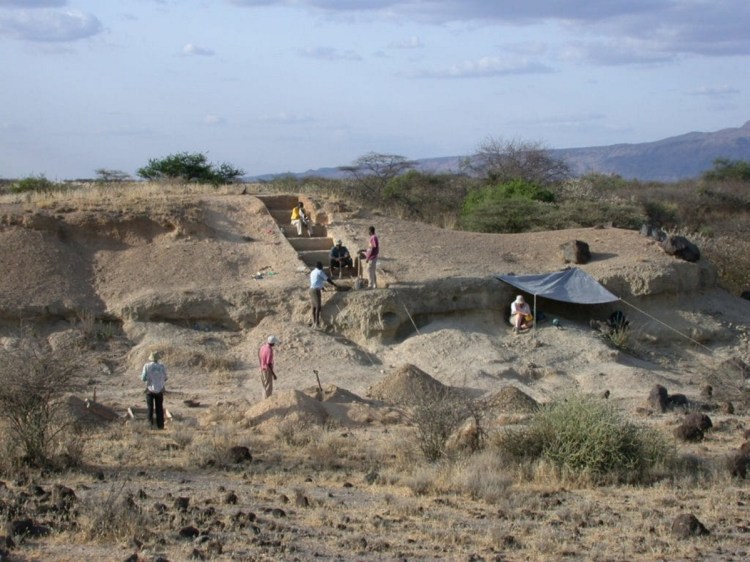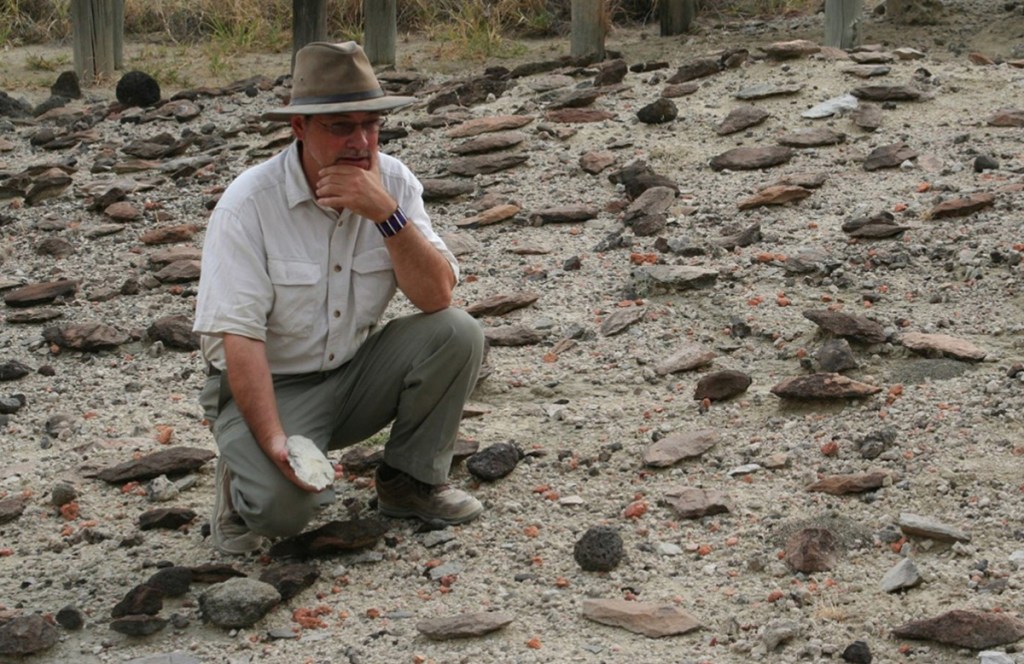In 320,000-year-old colored rocks and sophisticated stone tools uncovered at an archaeological site in southern Kenya, scientists say they’ve found early evidence of what makes humans unique.
The rocks show signs of being ground up for paint pigment – an indicator of ancient communication. And the stone for the tools comes from sources dozens of miles away – suggesting trade. Meanwhile, sediment cores bear evidence of centuries of climate chaos – a sign that the site’s inhabitants had to adapt to survive.
“It’s a package of behavior that seems really familiar,” said Smithsonian paleoanthropologist Rick Potts, who co-led the research. “We’re dealing with some very early evidence of the evolution of fundamental human capabilities very early in our species.”
In three studies published Thursday in the journal Science, Potts and his colleagues describe the major environmental, ecological and technological changes that unfolded in East Africa around the time our species evolved. Together, the studies paint a picture of the pressures that pushed humanity’s ancestors to communicate, trade and above all, adapt – behaviors that are now “part of Homo sapiens and who we are,” Potts said.
The artifacts were uncovered at Kenya’s Olorgesaile Basin, a dry, shrub-strewn expanse in the African Rift Valley that has been a cradle of humanity for more than 1 million years.
CLIMATE SWINGS
In the early days, this basin contained a lake, and the red, rocky landscape was traversed by grazing animals, migrating birds and early human ancestors called Homo erectus. A century of excavations by some of the most famous names in paleoanthropology, including Mary and Louis Leakey, has uncovered a wealth of artifacts from this period: a fossilized hominin forehead, butchered animal bones and scores of stone hand axes. These tools were heavy and powerful, the signature of an era of ancient hominin technology known as the Acheulean.
But then the environment began to change. Earthquakes shook the basin, causing the lake to evaporate. Digging through layers of sediments spanning 800,000 to 300,000 years ago, the researchers saw that the climate swung wildly from wet to arid and back again. Rivers sloshed through the basin, then vanished entirely. The animals that inhabited the landscape shifted, too: huge grass eaters, including giant baboons, hippos, zebras and elephants, went extinct and were replaced by smaller species with more varied diets.
When traces of hominins reappear, about 320,000 years ago, they look very different. Instead of bulky hand axes, the tools scattered throughout the site are small, finely crafted points carved from black volcanic glass called obsidian. But obsidian doesn’t naturally occur in the basin – it had to have been carried from many miles away.
This curiosity has stood out to Potts since he began working at Olorgesaile 34 years ago. Finally, in the early 2000s, he and George Washington University archaeologist Alison Brooks began to take a closer look.
Brooks, an expert in the phase of prehistory called the Middle Stone Age, immediately recognized the stone points as characteristic of the period. The tools were produced by gradually chipping away at a piece of stone, preparing the core so a single, final blow resulted in a flake of exactly the right shape and size. Some of the points were shaped into scrapers and awls; others bore a mark where they may have been attached to a shaft and used as spears.
“All of these things suggest complex weapons, complex technology, and … a more elaborate thought process to make them,” Brooks said.
SIGNS OF TRADE
Analysis of the stone revealed that nearly half the tools were carved from obsidian that originated 15 to 30 miles away across rugged terrain. But the flaked-off bits aren’t scattered across the landscape – instead, tens of thousands of shavings are concentrated in the basin.
To Potts and Brooks, this is a signature of trade. The hominins who brought this obsidian to Olorgesaile must have carried it whole, then left it for the basin’s inhabitants to cut into usable pieces.
An excavation uncovered another peculiarity: chunks of rich red rubble unlike the surrounding rock. One had narrow holes on each side, as if someone had been trying to bore through it. Close analysis with a high-power microscope revealed that the rocks had been scraped, likely to make ocher pigment.
This, too, must have been transported from far away. Consulting with the local Masai, Brooks concluded that there was nowhere to get this particular rock in Olorgesaile.
If the ocher really was used to make paint, it would be the earliest evidence of such behavior among humans and our close relatives.
“Coloring material is generally seen as evidence of complex symbolic behavior,” Potts said. “If you think of the ways we use color … it is usually a way of marking skin or hair or directions or something.”
Why would the ancient inhabitants of the Olorgesaile Basin have needed such markers? It goes back to trade, Potts said.
“If you’re expanding the geography of your survival, running into other groups and realizing they have this valued type of stone, and negotiating for it in some way or another … if it’s advantageous to create these social group interactions and maintain them, then what better way than some symbolic means of communication?”
The insecurity created by an unstable climate would have pushed the Olorgesaile people to be better, smarter and more opportunistic hunters. And they would have relied on the goodwill of their extended social networks to help them get by when times were tough.
“In essence, what we’re dealing with here is the origin of adaptability,” Potts said.
Send questions/comments to the editors.




Success. Please wait for the page to reload. If the page does not reload within 5 seconds, please refresh the page.
Enter your email and password to access comments.
Hi, to comment on stories you must . This profile is in addition to your subscription and website login.
Already have a commenting profile? .
Invalid username/password.
Please check your email to confirm and complete your registration.
Only subscribers are eligible to post comments. Please subscribe or login first for digital access. Here’s why.
Use the form below to reset your password. When you've submitted your account email, we will send an email with a reset code.